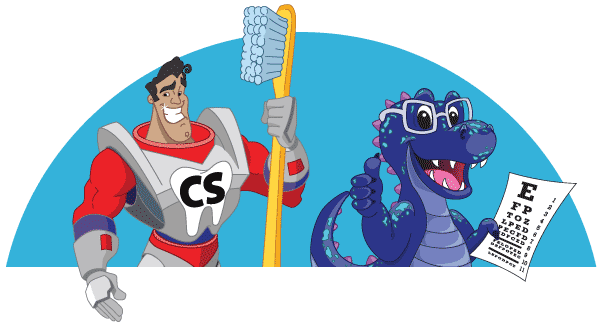Medicaid Dental Care for Kids
Milestones and Healthy Habits – 1 to 3 Years Old

When kids have healthy teeth and gums, they have better overall health. Your Medicaid dentist believes you’re never too young to eat teeth-healthy foods and take care of your oral health. Here are some of the milestones you can expect for your 1- to 3-year-old and teeth-healthy habits to establish with your toddler today.
Milestones
Most children will have all their baby teeth visible (erupt from the gums) by the time they turn 3. From approximately 6 months to 3 years old, you can expect 4 teeth to break through your toddler’s gums every 6 months. Often girls get their teeth in earlier than boys and typically lower teeth erupt before upper teeth. Teeth usually break through gums in pairs at the same time—one on the right side and one on the left.
Another important milestone for toddlers is the transition from bottle to cup. Children who are 1 to 3 years old should only drink from a cup. When kids use bottles past their first birthdays, it can lead to cavities. Start out by switching out a bottle for a sippy cup over time. So, maybe instead of a bottle with breakfast, you introduce a sippy cup. And, if your child uses a bottle at nap or bedtime, only fill it with water.
Healthy Habits
You should brush your toddler’s teeth two times a day for two minutes each time and always brush at bedtime. Once your child turns 1, you can use a very small amount (the size of a grain of rice) of fluoride toothpaste when you brush. You should brush every surface including your toddler’s tongue using tiny circles. Remember to start flossing once there are teeth right next to each other. Flossing every day is important! Your child should be involved in the brushing process, but at this age, an adult still needs to be responsible for brushing a toddler’s teeth.
Toothbrushes should be replaced every three to four months.
Be sure to introduce your toddler to teeth-healthy foods and drinks. Water should be a main drink for your toddler and you should avoid soda, sugary drinks and too much juice. The sugar in these drinks (even fruit juice and no-sugar added fruit juice) isn’t healthy for your child’s teeth. Fruit juice contains natural sugar that can also lead to cavities. Snacks that are healthy for your child’s body and also good for your child’s teeth include fruits, vegetables and cheese. Crackers, pretzels, fruit rolls and similar high-carbohydrate snacks feed the bacteria that cause cavities.
If your child enjoys a high-sugar or high-carbohydrate snack, be sure they rinse their mouth with water or brush their teeth afterward to remove food debris and sugar. Also, don’t allow continuous drinking or snacking. Your toddler’s teeth need time to repair. A constant barrage of food and drink can harm your child’s oral health.
Children should visit the Medicaid dentist at least twice a year to get a professional teeth cleaning and oral exam. At least every month (in between dentist visits) be sure to take a good look at your child’s teeth and gums since teeth can change quickly at this age. You want to spot any issues as early as you can.
What You Need to Know
Tooth decay usually starts along the gum lines. The first sign is usually a white spot. If you ever see anything unusual on your toddler’s teeth including spots that are brown, please contact your Medicaid dentist for an appointment.
Babies aren’t born with a preference for sweet food and drinks. It’s something they get exposed to as they get older and then continue to want to have sweet treats. The longer you can wait to introduce high-sugar foods the better it will be for your child’s health.
The more fun you can make the tooth-brushing routine, the higher chance your child will start to embrace the healthy habit. When you can, make brushing time a family time each day. You are your child’s biggest role model. When they see you eating and drinking tooth-healthy foods and brushing your teeth, they will want to be just like you. There are many videos and songs you can discover that help make brushing fun!

